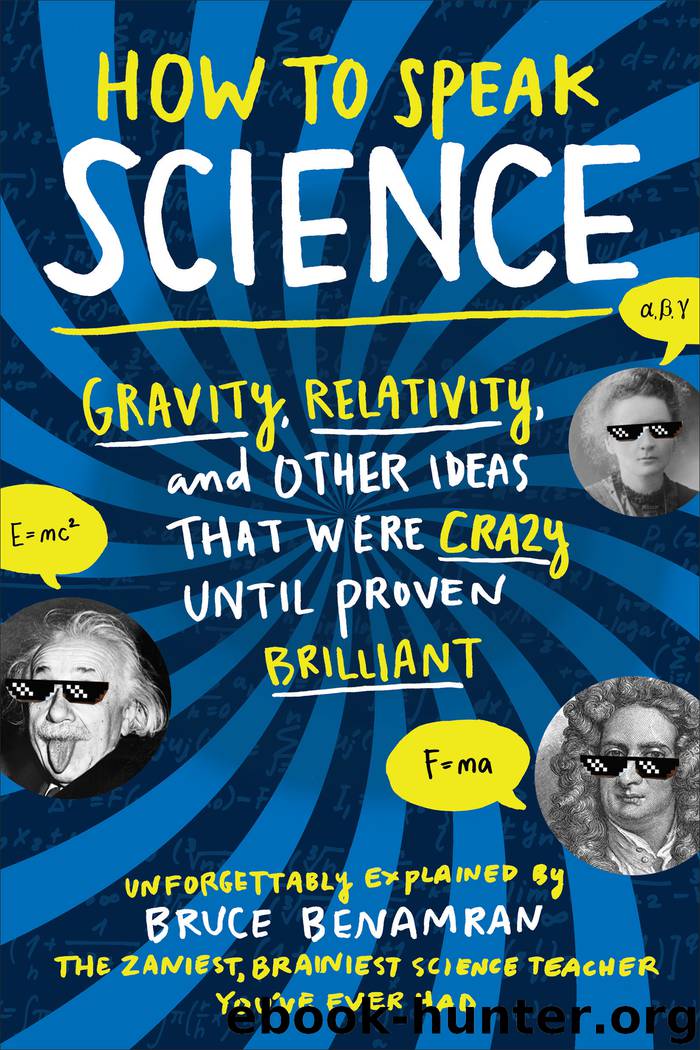How to Speak Science by Bruce Benamran

Author:Bruce Benamran
Language: eng
Format: epub
Publisher: The Experiment
In July, he perfected a water pump that he installed in the gardens of Padua. He discovered years later that it’s impossible for a suction pump to pump water from more than ten meters deep, yet he couldn’t explain why; but that’s another story, which involves Evangelista Torricelli. In December, he observed a nova, which completely contradicts the immutability of the sky proposed by Aristotle. In public, however, Galileo remained Aristotelian, feeling he still didn’t have enough proof—especially because the nova returned to its normal appearance.
Actually, I am most interested in October 1604, because that’s the month Galileo discovered the law of uniform acceleration, the outcome of his work on falling bodies. He showed that as long as objects are subject only to their own weight, and other forces such as air resistance are negligible, the fall of two objects under the same conditions does not depend on their mass, because their “inertial mass”—their inertia—exactly offsets their “gravitational mass”—what is traditionally called mass—namely, the quantity of matter. To demonstrate this, Galileo organized “slow-motion” falls, by sliding disks with different masses down iced inclined planes—kind of like our ball rolling on a slanted board experiment (see page 4)—the ice minimized the friction between the disks and the surface.
After 1604, Galileo entered his great astronomical period. In 1609, he received a letter from Paris from one of his students, telling him that the Dutch optician Hans Lippershey had developed a telescope that made it possible to see distant objects, magnifying them by up to seven times. Even though Lippershey’s telescopes were fairly ineffective due to multiple optical aberrations (weird effects), Galileo saw the potential and built his first telescope. In 1609, he finished the second version of his telescope and presented it to the Venetian senate. And mamma mia! They were so excited about the clarity of the image and the fact that the island of Murano and many other things seemed eight times closer than they really were.
Galileo offered the instrument and his inventor’s royalties to the Republic of Venice. The Republic of Venice then doubled his salary and guaranteed his university position for life. Finally! This gave him some financial breathing room. He then improved the design to magnify objects by more than thirty times and cleverly used a concave lens to correct the aberrations. But he wasn’t an engineer at heart, so the telescopes he made were only sort of effective. Though the design was excellent, the execution left something to be desired.
So Galileo set about watching the heavens and immediately found a ton of new evidence to challenge Aristotle’s guidelines. Because basically, according to Aristotle, there were two distinct worlds: the sublunary world, which includes the earth and everything up to the moon, and the superlunary world, which includes everything beyond, which was necessarily geometrically perfect—spherical—immutable and regular in its motions. Galileo looked at the moon and observed that the terminator—not Arnold Schwarzenegger, but rather the boundary line between the illuminated day side and dark night side of the moon—was irregular, and that the moon’s surface was studded with mountains.
Download
This site does not store any files on its server. We only index and link to content provided by other sites. Please contact the content providers to delete copyright contents if any and email us, we'll remove relevant links or contents immediately.
The Elements by Theodore Gray(3025)
Designing Your Life by Bill Burnett(2698)
The Chimp Paradox by Peters Dr Steve(2339)
The Meaning of it All by Richard Feynman(2318)
Why Is God Laughing?: The Path to Joy and Spiritual Optimism by Deepak Chopra(2239)
Tiny Habits by BJ Fogg(1928)
Cosmos by Carl Sagan(1694)
Women in Science by Rachel Ignotofsky(1683)
Predation ID Manual by Kurt Alt(1668)
Vaccine Epidemic by Louise Kuo Habakus(1635)
You're Not Listening by Kate Murphy(1596)
The Courage to Be Happy by Ichiro Kishimi & Fumitake Koga(1385)
The Science of Why by Jay Ingram(1355)
The Science of Superheroes by Mark Brake(1307)
The Dragons of Eden: Speculations on the Evolution of Human Intelligence by Carl Sagan(1227)
The Science of Why 2 by Jay Ingram(1210)
The Double Helix (1968) by 11. James D. Watson(1175)
Dragons of Eden by Carl Sagan(1143)
0345315367 by Carl Sagan(1133)
